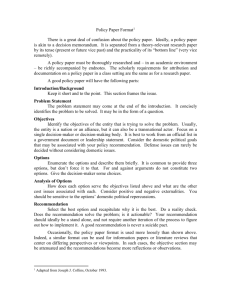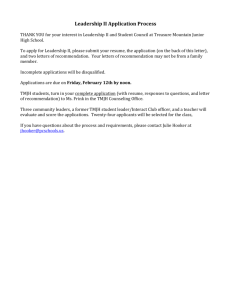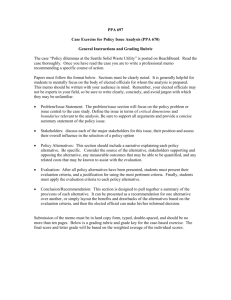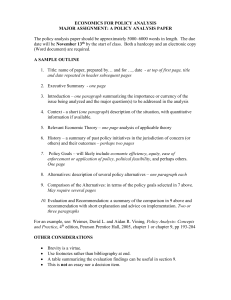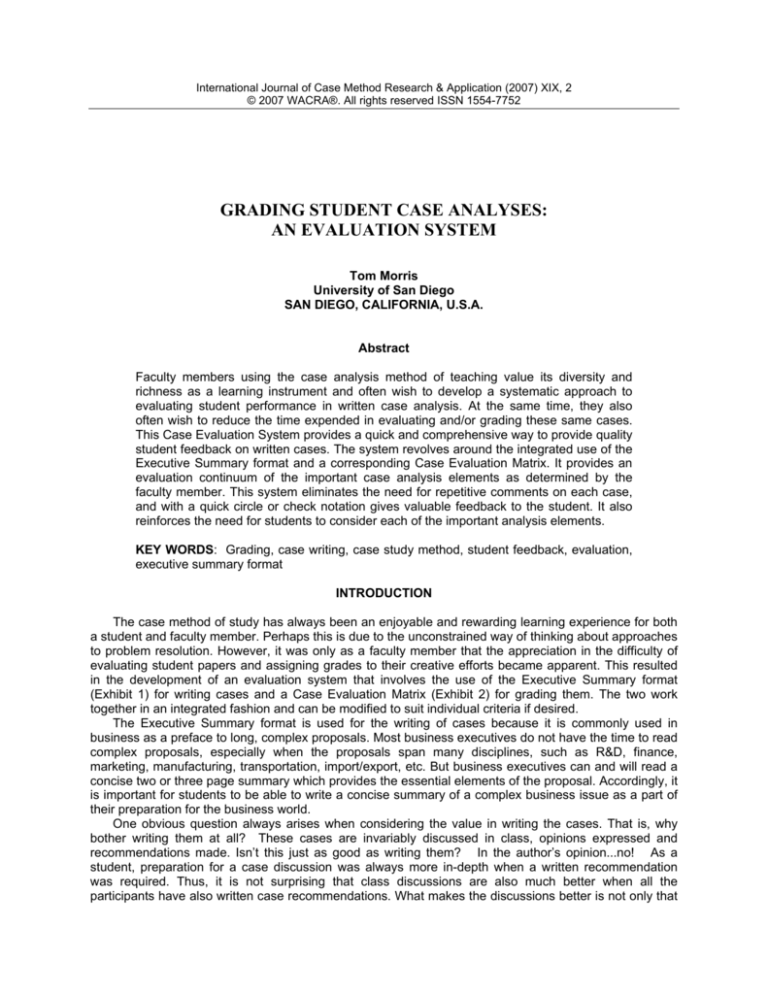
International Journal of Case Method Research & Application (2007) XIX, 2
© 2007 WACRA®. All rights reserved ISSN 1554-7752
GRADING STUDENT CASE ANALYSES:
AN EVALUATION SYSTEM
Tom Morris
University of San Diego
SAN DIEGO, CALIFORNIA, U.S.A.
Abstract
Faculty members using the case analysis method of teaching value its diversity and
richness as a learning instrument and often wish to develop a systematic approach to
evaluating student performance in written case analysis. At the same time, they also
often wish to reduce the time expended in evaluating and/or grading these same cases.
This Case Evaluation System provides a quick and comprehensive way to provide quality
student feedback on written cases. The system revolves around the integrated use of the
Executive Summary format and a corresponding Case Evaluation Matrix. It provides an
evaluation continuum of the important case analysis elements as determined by the
faculty member. This system eliminates the need for repetitive comments on each case,
and with a quick circle or check notation gives valuable feedback to the student. It also
reinforces the need for students to consider each of the important analysis elements.
KEY WORDS: Grading, case writing, case study method, student feedback, evaluation,
executive summary format
INTRODUCTION
The case method of study has always been an enjoyable and rewarding learning experience for both
a student and faculty member. Perhaps this is due to the unconstrained way of thinking about approaches
to problem resolution. However, it was only as a faculty member that the appreciation in the difficulty of
evaluating student papers and assigning grades to their creative efforts became apparent. This resulted
in the development of an evaluation system that involves the use of the Executive Summary format
(Exhibit 1) for writing cases and a Case Evaluation Matrix (Exhibit 2) for grading them. The two work
together in an integrated fashion and can be modified to suit individual criteria if desired.
The Executive Summary format is used for the writing of cases because it is commonly used in
business as a preface to long, complex proposals. Most business executives do not have the time to read
complex proposals, especially when the proposals span many disciplines, such as R&D, finance,
marketing, manufacturing, transportation, import/export, etc. But business executives can and will read a
concise two or three page summary which provides the essential elements of the proposal. Accordingly, it
is important for students to be able to write a concise summary of a complex business issue as a part of
their preparation for the business world.
One obvious question always arises when considering the value in writing the cases. That is, why
bother writing them at all? These cases are invariably discussed in class, opinions expressed and
recommendations made. Isn’t this just as good as writing them? In the author’s opinion...no! As a
student, preparation for a case discussion was always more in-depth when a written recommendation
was required. Thus, it is not surprising that class discussions are also much better when all the
participants have also written case recommendations. What makes the discussions better is not only that
154
International Journal of Case Method Research & Application (2007) XIX, 2
the students have thoroughly read and thought about the case, but that they have made a commitment in
writing (a recommendation) that somehow requires some defense, which leads to stronger support
positions for various alternative recommendations. This results in a livelier, more comprehensive case
discussion.
The problem for the faculty member leading this enhanced case discussion is, of course, how to deal
with all the written cases. (A brilliant graduate assistant comes in very handy here, but we are not always
blessed with one.) It was ultimately concluded that in order to develop good, concise, writing skills, some
qualitative feedback on each paper was required.
At one time, about half an hour was spent on each case, including written comments on each paper.
Several things happened when employing this method. First, hundreds of hours were spent commenting
on the papers, and the comments were very repetitive from one paper to the next. Second, after making
all the comments, there was no easy way of ordering them into a specific grading mechanism.
Fortunately, the structure of the Executive Summary format combined with the Case Evaluation Matrix,
make for an efficient evaluation of student papers and provide useful, high quality feedback. A
comprehensive case evaluation can now be completed in about ten minutes.
THE EXECUTIVE SUMMARY FORMAT
The Executive Summary Format (Exhibit 1) is particularly good for evaluating student cases because
it is structured and concise. When evaluating a large number of student papers, the identical structure of
each paper provides for a quick focus on the critical elements of the paper, including problem statement,
discussion and recommendation. Students receive a copy of this format before writing their first case. It is
also very helpful to provide a specific example of a case that has been written in this format. It is usually a
case that has been assigned for class discussion, and it provides the students with a good example to
follow. Sometimes, a good student paper may be used as an example if the case has been written before.
But more often, the author creates the example himself. The Executive Summary example of the case
may be handed out near the end of the class discussion and used as the concluding summary of the
case. Students find the specific example written in the required format extremely helpful in ordering their
thoughts and making the transition from thinking to writing. In virtually every class, the quality of written
cases improved dramatically after the sample was introduced, and it did not appear to stifle any creativity.
So naturally, this step is heartily recommended.
Some students find the limitation of three pages to be difficult, because they feel it does not allow for
a complete development and expression of ideas, particularly if the case is long and/or complex. It should
be pointed out that it is not intended to be an exhaustive analysis of all possible alternatives, but rather a
concise, focused summary with the alternatives only mentioned to ensure they received consideration. In
general, any issue, no matter how complex, can be summarized into three pages if the case is reduced to
its most essential elements. Exhibits, tables, financial analysis, etc. may be included as attachments and
are not typically included in the three-page limit.
INTRODUCTION
The introduction is used to provide some general background from the case and introduce the
particular issue that is the primary focus of the case. Typically, students use the introduction as a sort of
“warm up” for structuring their approach to the case. It’s usually a single, short paragraph, and students
are encouraged to use their own summary skills rather than any words from the case author.
PROBLEM STATEMENT
The problem statement is always the most difficult part of the format for students, partly because the
problem (or issue) is usually not directly stated in the case. However, this is the most important part of the
case analysis, because it requires a thoughtful analysis and synthesis of information. Most cases are
loaded with superfluous information that has little bearing on the real issue presented in the case, and a
clear statement of the problem allows for a focused recommendation. If the problem is fuzzy and not
clearly stated, then the resolution is usually equally fuzzy and does not bring closure to the issue. The
best problem statements can be made in a single sentence. For example, “Sales are declining, and
International Journal of Case Method Research & Application (2006) XIX, 2
155
profitability has slipped from 10 percent to 5 percent over the past five years.” Or, “The Acme Company
does not have sufficient capacity to meet the forecasted demand of 10 million units per year.” If possible
it is always better to quantify the problem, because it helps to bring specific closure to the
recommendation.
Students sometimes frame the problem in terms of a general solution, such as, “The company must
determine how to increase sales and increase profits.” Or, sometimes they even put the specific
resolution into the problem statement, such as, “The Acme Company must borrow sufficient capital to
build a new manufacturing plant.” It must be pointed out that these are not problems, but possible
solutions to unstated problems. When students introduce solutions in the problem statement, it eliminates
the discussion of alternatives.
ENVIRONMENTAL ANALYSIS
This section of the format allows the student to frame the issue in the appropriate context of the
department, the company, the industry, the product line, the market, etc. It provides the student the
industry norms that can be stated to show relationships and relative strengths or weaknesses. If
resources are an issue, this is the place to discuss it, as well as issues such as the market, competition,
customers, technology, government regulations, legal requirements, social trends, personnel,
interpersonal relations, etc. This section often consumes two pages of a three-page paper, and it can be
quite comprehensive.
ALTERNATIVE STRATEGIES
Clearly, there is always more than one way to resolve the stated problem. This section forces
students to consider alternative solutions. It does not require a comprehensive discussion of each
alternative, just a demonstration that the student is aware of the alternatives to counter the typical
challenges of, “Have you thought about..., etc.?” This is an opportunity for the student to demonstrate
creative insight as well as clear, logical reasoning.
RECOMMENDATIONS
This section becomes the essence of the paper. Assuming that the student has correctly identified the
problem, has conducted a thorough environmental analysis, and has come up with a few alternative
solutions, he/she is free to present the logic of the recommendation. The key here is whether or not the
recommendation actually resolves the stated problem. This seems like an obvious requirement, but many
students will make a very persuasive argument for their recommendation, only to ultimately find out that it
does not resolve the stated problem. The recommendations should be very specific. That is, a
recommendation to “increase capacity” must also be accompanied by an explanation of the approximate
cost and exactly how the resources to fund the increased capacity will be obtained. Not long ago, we
studied the airline industry and one of the specific airline companies in the industry. This particular airline
company was in Chapter 11 bankruptcy. However, this did not dissuade several students from
recommending “the acquisition of 50 new planes and expansion into international routes,” but without the
accompanying explanation on how much these planes might cost, or how the airline could afford to
acquire them. Clearly, any recommended strategy must be stated specifically, and it must also be
possible.
THE EVALUATION MATRIX
The matrix (Exhibit 2) presented in this paper has evolved over several years, and it can be used in
both graduate and undergraduate classes. It provides an evaluation continuum of the important case
analysis elements as determined by the faculty member. It eliminates the need for repetitive comments
on each case, and with a quick circle or check notation gives valuable feedback to the student. It also
reinforces the need for students to consider each of the important analysis elements.
At one time, the continuum was used to assign specific grades at each level, one for each analysis
component. The left-hand column of the matrix is reserved for this purpose and provides for a nice,
156
International Journal of Case Method Research & Application (2007) XIX, 2
straightforward grading mechanism. More recently, the specific grade assignment of each component has
been dropped in favor of the “holistic” nature of the effort when assigning a grade or score. This results in
a sort of structured subjectivity which is preferable to the inevitable weighting of each component to
determine a grade or score. In this format, the components are not equally weighted. For example, a
creative and insightful recommendation is not always accompanied by a comprehensive analysis of
issues. Both elements are required, but an excellent, intuitive recommendation is better than a thorough
analysis of issues that leads nowhere.
This matrix has been designed for use with this executive summary. However, it can be modified to
suit individual needs. If the instructor chose a written case format with six or eight important elements,
then the horizontal matrix could be expanded to accommodate the additional elements. For example, the
instructor might want to include alternative strategies as a key element, or one could choose fewer
elements but with different criteria. The progression or grading continuum on the vertical axis of the matrix
can likewise be expanded or contracted depending on one’s ability and desire to clearly differentiate the
steps in the continuum. For example, if the instructor wants to differentiate between five different grades,
A through F, then he/she needs five steps. If the instructor wants to differentiate only between three
grades, A, B and C, then he/she needs only three steps.
In this 5 X 5 matrix, three of the horizontal elements are the critical components of the case analysis:
problem identification, analysis of issues and specific recommendation. The other two elements are more
subjective, but they are necessary to acknowledge creativity and writing clarity. Generally, most papers
create a predictable set of alternatives and provide support for one or more predictable, well founded
reasons. However, sometimes a student will formulate a very unusual and creative recommendation that
can be acknowledged under the “creative insight” element.
The vertical grading continuum provides information that increases the student’s ability to structure
specific, well written papers. It tells them both what to do in order to meet expectations for a good paper
and what not to do to avoid being downgraded for a writing effort. Thus, by simply circling the appropriate
box in the matrix, the instructor is telling the student both what they have done and what they need to do
to improve their case presentation, and all without writing repetitive, time-consuming notes on each
paper.
The matrix does not necessarily remove the need for individual comments. Comments can be made
in the margins of each case and written at the bottom of the matrix page. However, because of the matrix,
it is no longer necessary to write a repetitive rationale for the grade on each paper.
CONCLUSION
This evaluation system is continually evolving. It clarifies expectations for a good paper, shows
students how to improve their writing, and reduces the time spent grading. It makes it easier to justify a
written case by creating a balance between the enhanced learning process and the time spent evaluating
it. Hopefully, someone else will find this system conceptually useful and be energized with an idea to
create an even better system. If the reader does so, please send the author a copy.
EXHIBIT 1
EXECUTIVE SUMMARY FORMAT
The executive summary is designed for the executive who wants an understanding of an issue, an
analysis and recommendation, but without all the analysis detail. Executive summaries are often the first
few pages of a comprehensive analysis, they are normally two pages, and they should never exceed
three pages (plus any attachments).
INTRODUCTION
The introduction is a brief, one-paragraph description of the major issues presented in the case. This
should include any economic, political, market or competitive issues. It may include organizational issues,
technical issues, financial issues, ethical issues, policy considerations, etc.
International Journal of Case Method Research & Application (2006) XIX, 2
157
PROBLEM STATEMENT
The problem statement is a specific statement of the problem or issue, usually not to exceed two
sentences. Remember that this is not a question nor a direction to proceed; it is only a statement of the
problem.
ENVIRONMENTAL ANALYSIS
The environmental analysis is an analysis of critical internal and external issues that bear most
significantly on the case. These issues may be related to a department, company, market, country,
product, competitor, company policy, industry, etc.
ALTERNATIVE STRATEGIES
Alternative strategies are possible alternative solutions to solve the problem. These should be specific
and distinct from one another. Briefly note advantages and disadvantages of each possible alternative.
One of the most useful purposes of this section is to demonstrate that you have not overlooked any
obvious alternatives.
RECOMMENDATION(S)
The recommendation is an explanation of your specific recommended strategy(ies), why you selected
that particular one and how it solves the problem. It might include an appropriate financial analysis. Be
sure your recommended strategy can be supported with available resources.
EXHIBIT 2
CASE EVALUATION MATRIX
Grade
Problem
Identification
Analysis
of issues
Recommendation
Creative
Insight
Writing
Style
Clear,
specific,
concise and
accurate
Comprehensive,
no omission
of issues
Clearly resolves
the problem
Original
with
unusual
insight
Stimulating
and has no
errors
Generally
accurate but
not concise
and specific
Includes most
important
issues
Solves the problem
in a general sense
only
Generally
good, solid
reasoning
Clear and
interesting
with no
errors
Part of the
problem not
identified
Overlooks
some
issues
Solves only a
part of the
problem
OK – but
suggests
only the
obvious
Clear, but
with a few
errors
158
International Journal of Case Method Research & Application (2007) XIX, 2
Vague
problem
definition
Omits some
of the
important
issues
Vague
problem
definition
Missing
some
insight
Difficult
to follow
Inaccurate
assessment
of the
problem
Omits all
of the
important
issues
Doesn’t
solve the
problem
at all
Misses
the
point
completely
Incomplete
thoughts,
confusing,
excessive
errors
COMMENTS



